Three-dimensional motion mixer achieves mixing through a combination of revolution, rotation, and tumbling motions. Its core components are constructed of stainless steel. Its highly adaptable design allows it to mix dry powders and granules, as well as wet materials containing small amounts of liquid or materials with large specific gravities, preventing stratification and agglomeration. The equipment supports customizable capacity, speed, and functional modules, meeting the diverse mixing needs of various industries, from pilot trials to mass production.
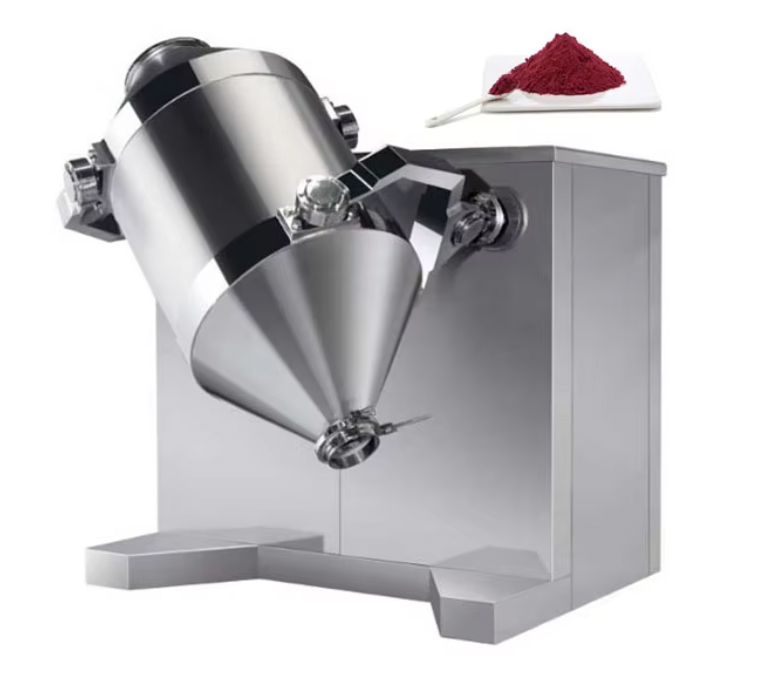
The three-dimensional motion mixer's mixing drum features multi-directional motion, accelerating the flow and diffusion of various materials during mixing. It eliminates centrifugal forces, gravitational segregation, stratification, and accumulation. It allows for a wide weight ratio of components, ensuring seamless mixing, ensuring optimal material quality and achieving a mixing efficiency exceeding 99.9%, making it an ideal choice for various mixing equipment.
The three-dimensional motion mixer, with its compound motion, offers outstanding advantages and strong adaptability. It can mix dry powders, granules, and wet materials containing liquids without disrupting the shape of fragile materials, completing the mixing process in 3-15 minutes.
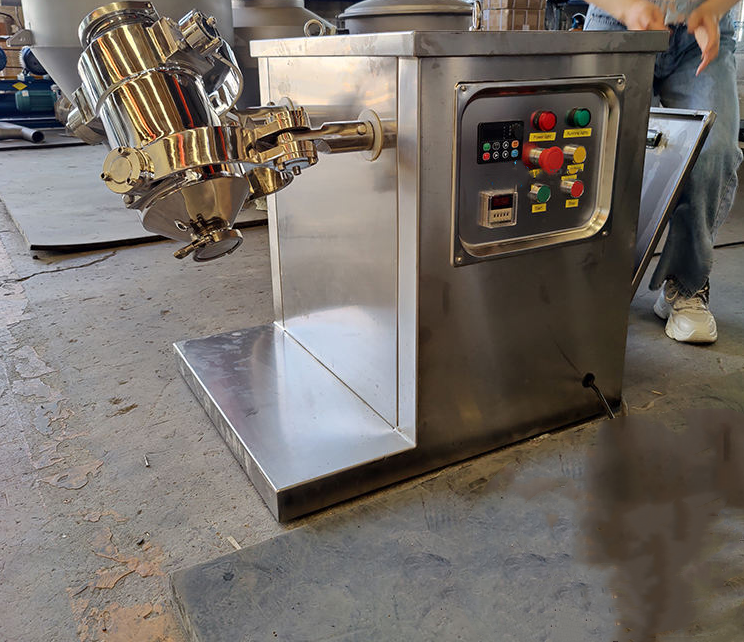
Multi-directional motion: The drum can move in multiple directions, eliminating centrifugal forces, gravitational segregation, stratification, and accumulation. The weight ratios of the components can vary significantly, resulting in a high mixing efficiency. It is currently the most ideal mixer available.
High mixing uniformity: The three-dimensional motion path covers every space within the container, achieving a mixing uniformity of over 98%.
Strong material adaptability: Whether it's flour with good flowability, chemical powders, granules with widely varying specific gravities, or wet materials containing small amounts of liquid, it can achieve high-speed mixing.
Clean, convenient, and hygienic: The mixing container is often constructed of stainless steel, with a smooth interior and no dead corners, meeting hygiene standards. The container can be quickly disassembled for easy cleaning and disinfection, preventing cross-contamination between batches of materials. Low energy consumption and high efficiency: By optimizing the motion trajectory design, materials can be mixed in a short time, and the energy consumption is reduced by 20%-30% compared with traditional mixers.
The three-dimensional motion mixer consists of four core components that work together to achieve multi-dimensional mixing. The base ensures stable operation, the drive system enables precise speed regulation, and the three-dimensional motion mechanism imparts a unique, complex motion trajectory to the mixing drum, ensuring full contact with the material.
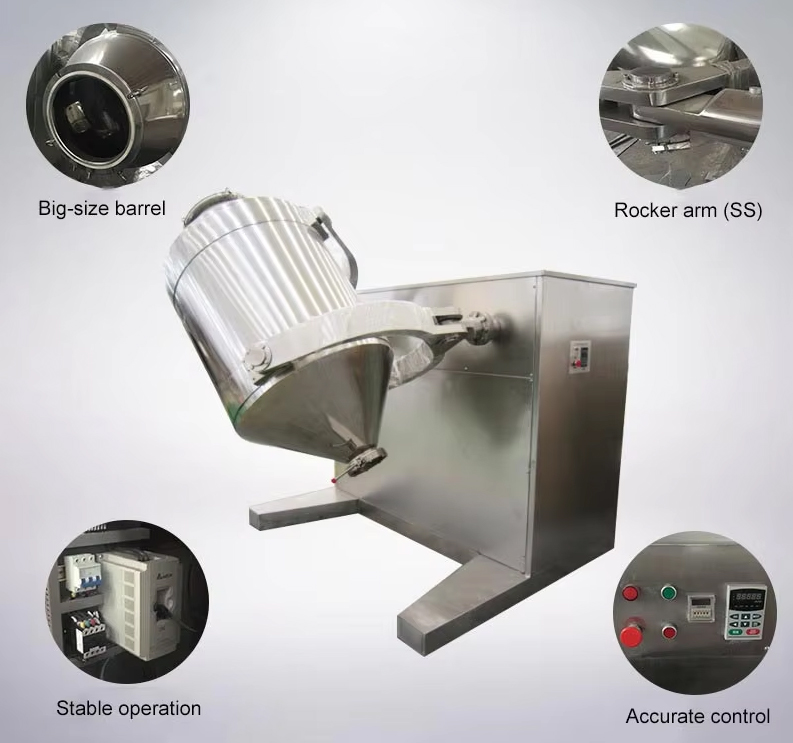
The base: Utilizing a steel frame and stainless steel mirror panels, the machine ensures overall stability and is suitable for industries requiring high cleanliness, such as pharmaceuticals and food.
The drive system: Integrates a motor, reducer, inverter, and PLC control system, supporting stepless speed regulation from 5-13 rpm and precise stop positioning.
The three-dimensional motion mechanism: A Y-type universal joint connects the master and slave shafts, enabling the mixing drum to achieve a combination of translational, rotational, and rocking motion.
The mixing drum: Crafted from high-quality stainless steel, its interior is mirror-polished to effectively minimize residual material. The eccentric cone discharge port, equipped with a butterfly valve, ensures zero-residue discharge.
The core of a three-dimensional motion mixer lies in its three-dimensional composite motion trajectory: revolution + rotation + tumbling. The device's mixing chamber, driven by a transmission system, simultaneously performs periodic motion around two intersecting axes. Within the chamber, the material undergoes a triple mixing action: diffusion, convection, and shear. Revolution drives the overall flow of the material, creating convection; rotation promotes interpenetration and diffusion; and tumbling motion generates a gentle shear force on the material, breaking up potential lumps.
Due to their high uniformity and adaptability, three-dimensional motion mixers are widely used in critical mixing processes across multiple industries. In the pharmaceutical industry, they are used to mix powdered excipients for Western medicines, homogenize traditional Chinese medicine powders, and prepare capsule fillers. In the food industry, they are suitable for blending complex seasonings (barbecue powders, soup base powders), baked grain powders, and candy fillings to ensure a consistent taste. In the chemical industry, they can mix plastic particles with masterbatches, coating powders, and pesticide powders. Furthermore, they are used to blend coating raw materials in the building materials industry and mix battery materials in the new energy sector, meeting the needs of a full range of scenarios, from laboratory trials to industrial mass production.
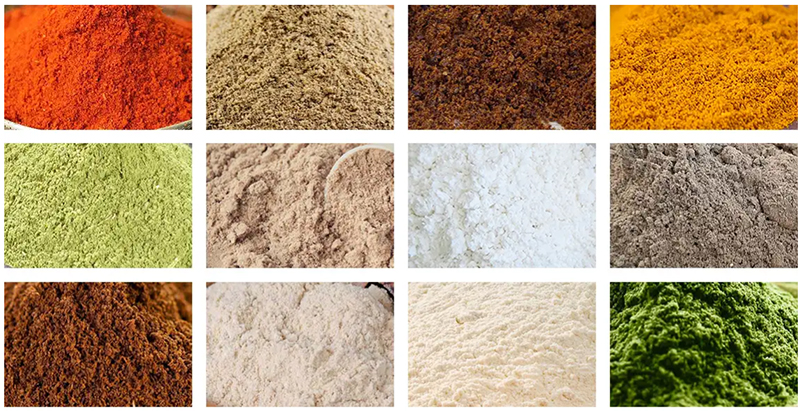
| Model | Full volume(L) | Loading factor(L) | Production capacity(kg) | Speed(r/min) | Motor power(kw) | Swing height(mm) | Dimensions(mm) |
| VH-20 | 20L | 30% | 6 | 15 | 0.37 | 1000 | 780*450*850 |
| VH-50 | 50 | 30% | 15 | 13 | 0.55 | 1350 | 1350*500*1150 |
| VH-100 | 100 | 30% | 30 | 13 | 0.75 | 1400 | 1530*650*1200 |
| VH-200 | 200 | 30% | 60 | 13 | 1.1 | 1750 | 1750*680*1550 |
| VH-300 | 300 | 30% | 120 | 13 | 1.1 | 1980 | 2150*710*1780 |
| VH-500 | 500 | 30% | 200 | 0-13 | 2.2 | 2150 | 2300*850*1900 |
| VH-1000 | 1000 | 30% | 400 | 0-12 | 4 | 2550 | 3020*1200*2350 |
| VH-1500 | 1500 | 30% | 600 | 0-11 | 5.5 | 2650 | 3300*1400*2400 |
| VH-2000 | 2000 | 30% | 800 | 0-10 | 5.5 | 2850 | 3500*1500*2650 |
The differences between a three-dimensional motion mixer and a conventional mixer primarily lie in core dimensions such as motion type, mixing effect, and material compatibility.
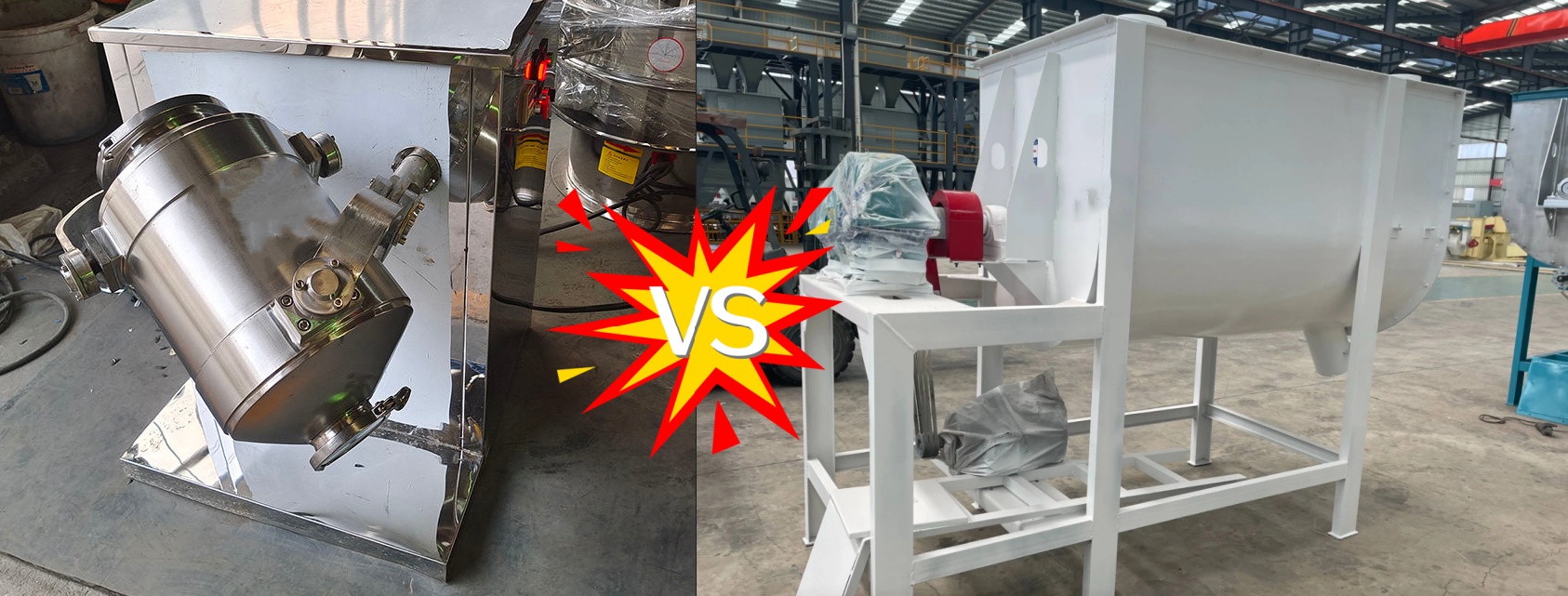
Motion and Mixing Principle: Conventional mixers typically use single-dimensional motion, such as horizontal mixers that rely on unidirectional propulsion with a ribbon or vertical mixers that rely on rotating impellers. This can easily create dead zones in the container due to the fixed motion trajectory. A three-dimensional motion mixer, on the other hand, uses a compound motion of "revolution + rotation + tumbling" to drive the material to tumble irregularly within the space, achieving full, seamless mixing.
Mixing Uniformity and Efficiency: Conventional mixers tend to separate materials with large differences in specific gravity or particle size, resulting in uniformity levels of 85%-90%, and mixing times typically requiring 15-30 minutes. A three-dimensional motion mixer can achieve uniformity levels exceeding 98% and shorten mixing times to 3-15 minutes, making it particularly suitable for applications requiring high uniformity.
Material adaptability: Ordinary mixers have difficulty handling liquid-wet materials, fragile crystals, or materials with large differences in specific gravity, and are prone to agglomeration or destruction of material form. Three-dimensional motion mixers are compatible with dry powders, granules, liquid materials, etc., and the motion intensity is controllable, which can protect fragile materials and has a wider range of adaptability.
As a professional three-dimensional motion mixer manufacturer, our mixers are widely used in various industries and offer customized mixing solutions.

Laboratory R&D: To overcome the bottleneck of uniformity in graphene conductive coatings, we introduced a laboratory-grade three-dimensional motion mixer. This device utilizes a combination of revolution and rotation to thoroughly mix graphene micropowder with various components, including the resin base and dispersant. A variable frequency speed control system precisely controls the mixing intensity to prevent graphene agglomeration.
A medium-sized seasoning factory: Needing to solve the mixing challenge of "oil, powder, and particles" in barbecue seasoning, they selected a three-dimensional motion mixer with a liquid spray module. Cooking oil is evenly sprayed in through a customized interface. The device utilizes a combination of translation, rotation, and rocking motion to thoroughly mix chili powder, sesame powder, cumin powder, and other ingredients with the oil, preventing clumping and reducing batch mixing time to just 8 minutes.
A chemical company: When producing broad-spectrum pesticides, they face the mixing challenge of a large difference in the specific gravity of the highly active active ingredient and the inert carrier. The introduction of an industrial-grade three-dimensional motion mixer utilizes its seamless three-dimensional motion trajectory to achieve repeated cross-convection of the active ingredient powder and talc carrier within a sealed container, effectively eliminating stratification and segregation. The device supports switching between dry and wet mixing, eliminating the need for equipment replacement when adapting to the adhesive addition process.
Our three-dimensional motion mixers are constructed from food-grade 304 stainless steel, with 316L stainless steel optional for some models. The barrel is precision-polished, eliminating dead corners and preventing material stagnation. Starting at $1,500, our models cover a full range of capacities, from 1L laboratory micro-machines to 7,000L industrial large-scale units. Customization is also available, allowing us to adjust the size, speed, and functional modules to suit the customer's workshop space and material characteristics, such as adding a liquid spray device or explosion-proof system.
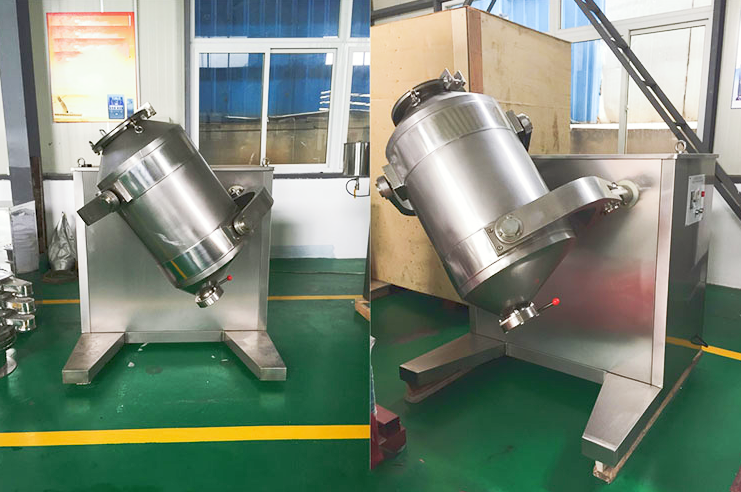
In industries such as pharmaceuticals, chemicals, food, and metallurgy, uniform mixing of materials is crucial for ensuring product quality. Traditional mixing equipment can easily cause material gravity segregation due to centrifugal force. However, the three-dimensional motion mixer, with its unique three-dimensional compound motion mechanism, has become a "black technology" that solves this mixing problem.
Address:China,Yanjin county forest park gate to the west 1000 meters north road.